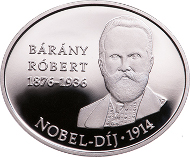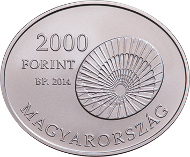November 27, 2014 – Although physician Róbert Bárány is less known in Hungary than in Austria, based on his background and fundamental work he has been included in the MNB’s (Magyar Nemzeti Bank, Central Bank of Hungary) series of collector coins commemorating Hungarian Nobel Prize winners started in 2012, to mark the 100th anniversary of his being awarded the Nobel Prize in Medicine.
Hungary/ 5,000 HUF/ Silver .925/ 12.5 g/ 30×25 mm/ Designer: Fanni Vékony/ Mintage: 5,000.
The HUF 5000 silver coin and HUF 2000 non-ferrous metal coin commemorating Róbert Bárány were designed by Fanni Vékony. On the front of the coin, the depiction of the spiral staircase refers to the cochlea of the inner ear, as well as dizziness and a vortex. The back side of the coin bears a portrait of Bárány.
Róbert Bárány was an Austrian doctor of Hungarian descent and later a university professor in Sweden. His father, Ignác Bárány, was a bank official, who moved from Rohonc (present-day Rechnitz in Austria) to Vienna before his son was born. The Bárány family settled in Várpalota in 1750 and one branch still lives there. His mother was Maria Hock, the daughter of a well-know historian from Prague. Róbert, the oldest of six children, was born in Vienna, but based on his correspondence later in life it is likely that he understood Hungarian.
He completed his medical studies in 1900 at the University of Vienna. From 1905, he worked at the university clinic, from 1909 as a lecturer. His main field of scientific research was the role of the inner ear and vestibular apparatus in balance and its connection to the brain. Based on his experiences, he developed methods for checking the vestibular functions, which he summarised in the work “The physiology and pathology of the human vestibular apparatus (balance organ)” in 1907. In his book, amongst others he cited the studies of Endré Högyes on human sense of balance published only in Hungarian and relevant research results of the physicist Ernst Mach.
Hungary/ 2,000 HUF/ Cupro-nickel/ 10.3 g/ 30×25 mm/ Designer: Fanni Vékony/ Mintage: 5,000.
In 1914, the Swedish Royal Academy awarded Róbert Bárány the Nobel Prize in Medicine for his research on the physiology of the ear and the sense of balance, which Bárány was unable to accept due to military service. At the beginning of the First World War, Bárány was working as a doctor in the military hospital at the fortress of Przemysl, where he was captured in 1915. With the personal intervention of Prince Carl of Sweden and the help of the Red Cross, he was released in 1916 and was then able to receive his Nobel Prize. He returned to Vienna, where a plagiarism suit was launched against him and his appointment as a university professor was prevented. He cleared his name before the court and, taking advantage of the option related to the Nobel Prize, moved to Sweden and became a Swedish citizen. From 1926 until his death he worked as the professor of otology at the University of Uppsala. He was awarded an honorary doctorate from the University of Stockholm in 1924.
Source: Fizikai Szemle 1996/4, Interview of Anders Bárány by György Marx, Múlt-kor 2006.04.21.
Other coins in the series so far include Albert Szent-Györgyi and Jenö Wigner.
Find out more about the Hungarian Mint’s commemorative coins.








